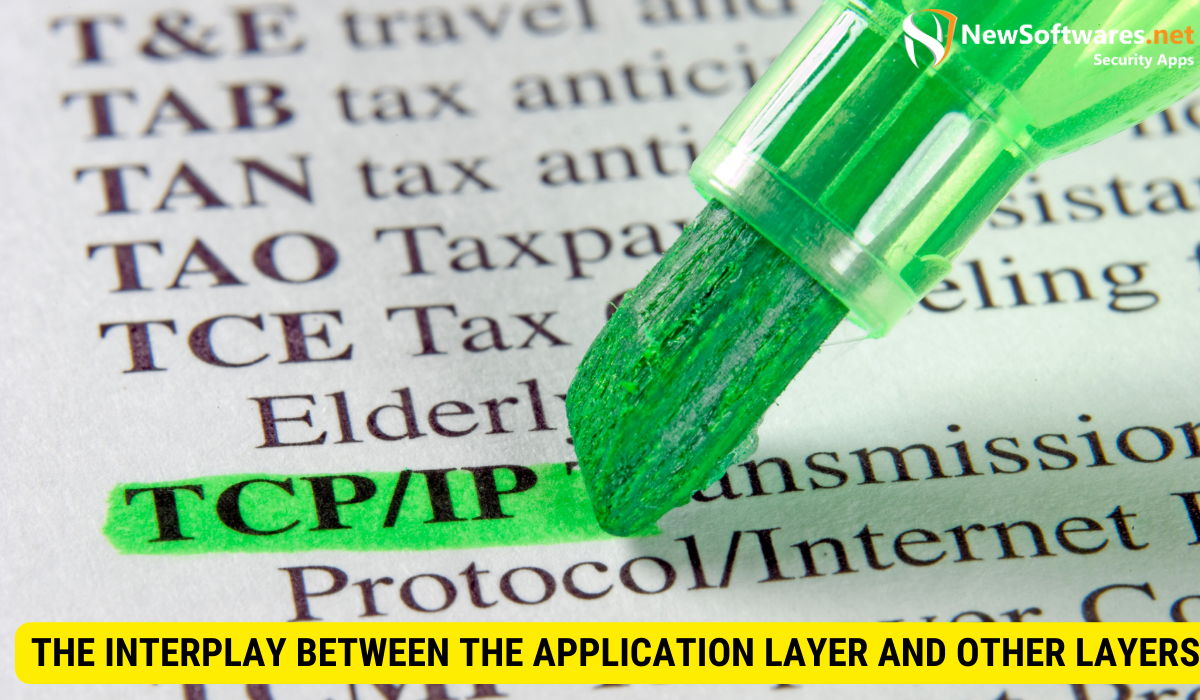The layer in the TCP/IP model responsible for formatting, compressing, and encrypting data is the application layer. This layer plays a vital role in ensuring data is correctly organized, compressed for efficient transmission, and encrypted for security. It interacts with other layers in the TCP/IP model to facilitate seamless data communication in computer networks.
Data transmission is crucial in ensuring seamless communication between devices in today’s interconnected world. One of the key elements in this process is the TCP/IP model, which provides a structured framework for formatting, compressing, and encrypting data. Understanding the layers within this model is essential for comprehending how data is handled in the digital realm.
Understanding the TCP/IP Model

The TCP/IP model serves as a conceptual framework delineating the roles of different protocols employed within computer networks. It comprises four distinct layers, namely the application layer, transport layer, internet layer, and network access layer. Each of these layers is endowed with specific responsibilities, all of which play a crucial role in ensuring the effective transmission of data.
The Four Layers of TCP/IP Model
The application layer is responsible for direct interaction with users or applications at the uppermost level. This layer offers various services, including file transfer, email communication, and web browsing. For instance, when you compose and send an email, the application layer protocols take care of the formatting and encoding of the message, ensuring that it is correctly organized and can be comprehended by the recipient’s email client.
Underneath the application layer is the transport layer, which ensures data delivery between hosts by segmenting and reassembling data. This layer is responsible for breaking down large chunks of data into smaller, manageable segments that can be transmitted across the network. It also provides error detection and recovery mechanisms, ensuring that the data arrives intact and in the correct order. One of the most well-known protocols at this layer is the Transmission Control Protocol (TCP), which guarantees reliable and ordered data delivery.
Moving down the stack, we encounter the internet layer. This layer is responsible for routing and forwarding data packets across different networks. It uses IP (Internet Protocol) to assign unique addresses to devices on the network and determines the most efficient path for data transmission. Additionally, the internet layer handles fragmentation and reassembly of packets, as well as addressing and routing protocols. An example of a protocol at this layer is the Internet Control Message Protocol (ICMP), used for network diagnostics and error reporting.
Lastly, the network access layer deals with the physical transmission of data, including the protocols used to establish and maintain the connection. This layer is concerned with the hardware aspects of network communication, such as the physical cables, network interface cards (NICs), and the electrical signals used to transmit data. It encompasses protocols like Ethernet, Wi-Fi, and DSL, which define how data is transmitted over specific types of physical media.
The Role of TCP/IP in Data Transmission
In each TCP/IP model tier, data undergoes formatting, compression, and encryption to meet particular criteria. This guarantees that the data can be transmitted and comprehended by the receiving device or application successfully.
For example, data is often formatted according to specific protocols at the application layer. In the case of web browsing, the Hypertext Transfer Protocol (HTTP) is used to format and structure web page requests and responses. This includes specifying the type of request (e.g., GET or POST), the URL of the requested resource, and any additional headers or parameters.
Additionally, data may be compressed at various layers to optimize transmission efficiency. Compression algorithms, such as gzip or deflate, can be applied to reduce data size before transmission. This is particularly useful for bandwidth-constrained networks or when transmitting large files.
Encryption is another important aspect of data transmission, especially when dealing with sensitive information. Secure protocols like HTTPS (HTTP over SSL/TLS) use encryption algorithms to protect data from unauthorized access or tampering. This guarantees that data remains confidential and secure during transmission over potentially insecure networks.
Overall, the TCP/IP model provides a comprehensive framework for understanding the layers and protocols involved in data transmission. Breaking down the process into distinct layers allows modular design, easier troubleshooting, and interoperability between network devices and technologies.
The Application Layer in Detail
The application layer is where the action happens. It is responsible for providing services and protocols that enable user applications to communicate with the network. Let’s explore the various aspects of the application layer in more detail.
The Role of the Application Layer
The application layer interfaces between the user and the underlying network. It allows users to access network resources and services, facilitating tasks such as email sending and receiving, file transfer, and remote server access.
Formatting Data at the Application Layer
When a user requests data from a remote server, the application layer ensures that the data is properly formatted for transmission. This includes organizing the data into packets efficiently transported across the network.
The application layer also guarantees that data complies with the relevant protocol standards. For example, it ensures adherence to HTTP for web browsing and SMTP for email communication. Following these standards enables smooth data exchange among various systems.
Data Compression Techniques in the Application Layer
In addition to formatting, the application layer may employ data compression techniques to minimize the amount of data that needs to be transmitted. Compression algorithms reduce the file size by eliminating redundant or unnecessary information, resulting in faster data transfer and decreased bandwidth utilization.
The Process of Data Encryption at the Application Layer
Data encryption is another crucial function carried out by the application layer. It involves converting data into an encoded format that can only be decoded with the correct decryption key. This process guarantees that the information remains safe and incomprehensible to unauthorized parties in the event of data interception.
Encryption algorithms such as AES or RSA offer robust security measures to safeguard sensitive information, such as passwords, financial data, and personal details. Through data encryption at the application layer, the TCP/IP model bolsters the overall security of data transmission.
The Importance of Data Formatting, Compression, and Encryption
Data formatting, compression, and data encryption are crucial for several reasons, including ensuring data integrity, speeding up transmission, and enhancing security.
Ensuring Data Integrity through Formatting
By formatting data in accordance with protocol standards, the application layer ensures that the data remains intact during transmission. This prevents data corruption or loss, ensuring that the information received by the destination device matches the original data sent by the source device.
Furthermore, proper formatting allows for error detection and correction techniques to be implemented, ensuring the reliability of data transmission. These techniques help identify and repair errors during transfer, further enhancing data integrity.
Speeding Up Transmission with Data Compression
Data compression techniques employed at the application layer significantly reduce the size of data packets. This reduction in size translates into faster transmission speeds and reduced network congestion. Files and documents can be transferred more quickly, allowing users to access information promptly and efficiently.
Data compression also optimizes bandwidth utilization, permitting the transmission of more significant amounts of data without overburdening the network infrastructure. This plays a crucial role in improving performance, especially in bandwidth-limited scenarios.
Enhancing Security with Data Encryption
Data encryption is essential for safeguarding sensitive information from unauthorized access. By encrypting data at the application layer, the TCP/IP model adds an additional layer of security to protect user data during transmission.
Encrypting data is crucial in safeguarding against eavesdropping and unauthorized interception, guaranteeing exclusive access and decryption rights solely for the designated recipient. This significance becomes particularly pronounced when dealing with sensitive or private data, such as financial transactions or medical records, necessitating a robust security posture.
The Interplay Between the Application Layer and Other Layers

The application layer does not operate in isolation but instead interacts with the other TCP/IP model layers to facilitate data transmission.
Interaction of the Application Layer with the Transport Layer
The application layer relies on the transport layer for reliable data delivery between hosts. It utilizes transport layer protocols, such as TCP or UDP, to establish connections, manage transmission control, and handle potential errors or congestion.
Through this interaction, the application layer ensures that data is delivered accurately and consistently to its destination, regardless of the distance or complexity of the network infrastructure.
How the Application Layer Affects the Internet Layer
The application layer provides the necessary information to the internet layer for routing data across networks. The application layer enables routers to correctly forward packets to their intended destinations by encapsulating data packets with addressing information.
This interplay between the application and internet layers ensures that data is routed efficiently, reducing latency and improving overall network performance.
The Application Layer’s Influence on the Network Access Layer
Finally, the application layer relies on the network access layer to physically transmit data. This layer defines the protocols and standards for establishing connections and transferring data over physical media, such as Ethernet or Wi-Fi.
By interacting with the network access layer, the application layer ensures a seamless transition from logical data representation to physical data transmission, enabling end users to access network resources effortlessly and reliably.
FAQs
What is the TCP/IP model, and why is it essential for data transmission?
The TCP/IP model is a framework for structuring data transmission in computer networks. It’s vital for understanding how data is handled in digital communication.
How many layers are there in the TCP/IP model, and what are their specific roles?
The TCP/IP model consists of four layers: application, transport, internet, and network access, each with distinct responsibilities in data transmission.
What is the role of the application layer in the TCP/IP model?
The application layer handles interaction between users and the network, including data formatting, compression, and encryption.
Why is data compression important in data transmission?
Data compression reduces the size of data packets, leading to faster transmission, reduced network congestion, and optimized bandwidth utilization.
How does data encryption at the application layer enhance data security during transmission?
Data encryption ensures that sensitive information remains confidential and secure from unauthorized access or interception, making it crucial for secure communication.
Key Takeaways
- TCP/IP Model: The TCP/IP model is a framework for data transmission in computer networks, consisting of four layers: application, transport, internet, and network access.
- Application Layer: The application layer interacts between users and the network, handling tasks like data formatting, compression, and encryption.
- Formatting Data: At the application layer, data is formatted according to specific protocol standards, ensuring adherence to standards like HTTP and SMTP.
- Data Compression: Data compression techniques reduce data size, leading to faster transmission and optimized bandwidth utilization.
- Data Encryption: Data encryption at the application layer protects sensitive information, ensuring confidentiality and security during transmission.
- Interplay Between Layers: The application layer interacts with other TCP/IP model layers, including the transport layer for data delivery, the internet layer for routing, and the network access layer for physical transmission.
Conclusion
The TCP/IP model layer dedicated to formatting, compressing, and encrypting data is crucial in facilitating smooth and secure data transmission. Through its various responsibilities, the application layer ensures that data is correctly formatted, compressed to optimize bandwidth utilization, and encrypted to protect sensitive information.
Furthermore, the application layer interacts with other TCP/IP model layers to enable reliable data delivery, efficient network routing, and seamless physical transmission. By understanding the intricacies of this layer, users can appreciate the complexities behind the scenes of data communication, ultimately leading to a deeper comprehension of the digital world we live in.
